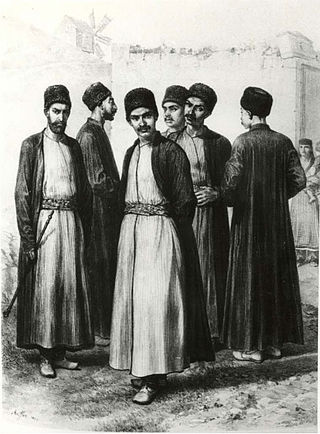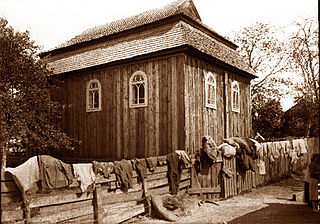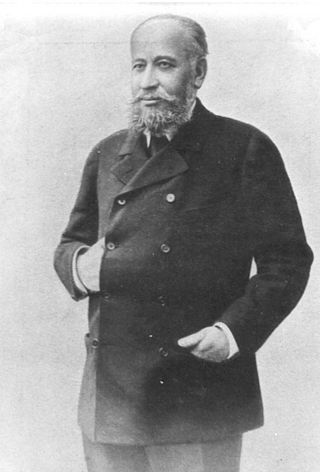
A synagogue, also called a shul or a temple, is a place of worship for Jews and Samaritans. It has a place for prayer where Jews attend religious services or special ceremonies such as weddings, bar and bat mitzvahs, choir performances, and children's plays. They also have rooms for study, social halls, administrative and charitable offices, classrooms for religious and Hebrew studies, and many places to sit and congregate. They often display commemorative, historic, or modern artwork alongside items of Jewish historical significance or history about the synagogue itself.

The Romaniote Jews or the Romaniotes are a Greek-speaking ethnic Jewish community. They are one of the oldest Jewish communities in existence and the oldest Jewish community in Europe. The Romaniotes have been, and remain, historically distinct from the Sephardim, some of whom settled in Ottoman Greece after the expulsion of Jews from Spain and Portugal after 1492.
Karaism is a non-Rabbinical Jewish sect characterized by the recognition of the written Tanakh alone as its supreme authority in halakha and theology. Karaites believe that all of the divine commandments which were handed down to Moses by God were recorded in the written Torah without any additional Oral Law or explanation. Unlike mainstream Rabbinic Judaism, which regards the Oral Torah, codified in the Talmud and subsequent works, as authoritative interpretations of the Torah, Karaite Jews do not treat the written collections of the oral tradition in the Midrash or the Talmud as binding.
The Krymchaks are Jewish ethno-religious communities of Crimea derived from Turkic-speaking adherents of Rabbinic Judaism. They have historically lived in close proximity to the Crimean Karaites, who follow Karaite Judaism.

The Crimean Karaites or simply Karaites, also known more broadly as Eastern European Karaites, are a traditionally Turkic-speaking Judaic ethnoreligious group indigenous to Crimea. Nowadays, most Karaim in Eastern Europe speak the dominant local language of their respective regions.

Berdychiv is a historic city in Zhytomyr Oblast, northern Ukraine. It serves as the administrative center of Berdychiv Raion within the oblast. It is 44 km (27 mi) south of the administrative center of the oblast, Zhytomyr. Its population is approximately 73,046.

A kenesa is an Eastern European or Persian Karaite synagogue.

House with Chimaeras or Horodetsky House is an Art Nouveau building located in the historic Lypky neighborhood of Kyiv, the capital of Ukraine. Situated across the street from the President of Ukraine's office at No. 10, Bankova Street, the building has been used as a presidential residence for official and diplomatic ceremonies since 2005. The street in front of the building is closed off to all automobile traffic, and is now a patrolled pedestrian zone due to its proximity to the Presidential Administration building.

Moorish Revival or Neo-Moorish is one of the exotic revival architectural styles that were adopted by architects of Europe and the Americas in the wake of Romanticist Orientalism. It reached the height of its popularity after the mid-19th century, part of a widening vocabulary of articulated decorative ornament drawn from historical sources beyond familiar classical and Gothic modes. Neo-Moorish architecture drew on elements from classic Moorish architecture and, as a result, from the wider Islamic architecture.

Subbotniks is a common name for adherents of Russian religious movements that split from Sabbatarian sects in the late 18th century.

Ruzhyn is an urban-type settlement in Berdychiv Raion, Zhytomyr Oblast, Ukraine. Prior to the administrative reform of 2020, it served as the administrative centre of the former Ruzhyn Raion. Population: 4,209

Haisyn or Haysyn is a city in central Ukraine. It serves as the administrative center of Haisyn Raion within Vinnytsia Oblast. It is located on the Sob in the eastern part of the historical region of Podolia. Its population is 25,698.

The Brodsky Synagogue, also called the Brodsky Choral Synagogue, is an Orthodox Jewish synagogue located in Kyiv, Ukraine.

The Karaite Synagogue is a Karaite Jewish congregation and synagogue or kenesa, located on Dere Street, in Hasköy, in the Beyoğlu district of Istanbul, in the Istanbul Province of Turkey. Completed in 1842, the synagogue is open, yet only open for the Karaite Passover services, or by arrangement.

The Moussa Dar'i Synagogue is a former Karaite Jewish synagogue or kenesa, located at 25 Sebyl El Khazindar Street, Midan el Gueish, in the Abbasiyah area of the Al-Daher district in western Cairo, Egypt. The synagogue was completed in 1931.

Lazar Izrayilevich Brodsky was a Russian businessman of Jewish origin, sugar magnate, philanthropist and patron.

The Kharkiv Choral Synagogue is an Orthodox Jewish synagogue, located at 12 Pushkinska Street, Kharkiv, in the Kharkiv Oblast of Ukraine. The Chabad congregation worships in the synagogue, also called Beit Menachem, reportedly the largest synagogue in Ukraine, and a building of architectural significance.

The Trakai Kenesa is a former Qaraite Jewish congregation and synagogue, or kenesa, located at 30 Karaimų Street, in Trakai, in the Vilnius County of Lithuania.

The history of the Jews in Odesa dates to 16th century. Since the modern city's founding in 1795, Odesa has been home to one of the largest population of Jews in what is today Ukraine. Odesa was a major center of Eastern European Jewish cultural life. From Odesa sailed the SS Ruslan which is considered the mayflower of Israeli culture. They comprised the largest ethno-religious group in the region throughout most of the 19th century and until the mid-20th century when the Jews were massacred by Romanian forces occupying the city or deported to be later killed during the Holocaust.






















